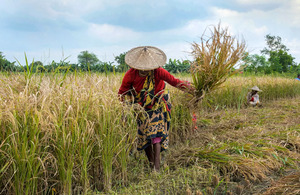 PTI
PTISeveral districts in Bihar, Jharkhand and West Bengal where sowing of kharif crops was less than 75% due to deficiency in rains during the monsoon season, are likely to go in for early rabi planting, said a senior official from the Ministry of Agriculture and Farmers' Welfare.
"West Bengal has provided alternative seeds to over 1,00,000 farmers. Now the state would go for early rabi crops," said the official, who did not want to be named.
In Jharkhand, seeds for early rabi crops have been distributed at subsidised rate, the official added.
There are 10 districts in Bihar, 20 in Jharkhand and four in West Bengal where planting of kharif crops did not happen on more than a quarter of the farmland, the official said. This land is available for early sowing of rabi crops.
"In Jharkhand and Bihar, the early rabi crops could be potato followed by rice and in West Bengal it could be either potato followed by rice or rice followed by rice," said Priyanka Mallick, managing director of Q&Q Research Insights. Her company works with farmers in Bihar, Jharkhand and West Bengal across multiple crops.
Rabi is the dry weather crop which is usually sown in November.
Farmers in the eastern part of the country have lost one season due to a deficiency in rainfall during the ongoing kharif season.
"The rainfall in September and October has helped in enhancing the soil moisture and will help in early sowing of rabi crops in districts where sowing of kharif crops could not take place," said Rohit Khaitan of Shyam Agro Biotech, a wheat miller from Asansol in West Bengal.
The country overall received 7% more rains than the long-term average during the 2022 June-September monsoon season. But several regions received less than normal rainfall. Some other regions received normal to surplus rainfall overall, but faced a deficiency during the crucial sowing season. These factors could weigh on agricultural production.
"West Bengal has provided alternative seeds to over 1,00,000 farmers. Now the state would go for early rabi crops," said the official, who did not want to be named.
In Jharkhand, seeds for early rabi crops have been distributed at subsidised rate, the official added.
There are 10 districts in Bihar, 20 in Jharkhand and four in West Bengal where planting of kharif crops did not happen on more than a quarter of the farmland, the official said. This land is available for early sowing of rabi crops.
"In Jharkhand and Bihar, the early rabi crops could be potato followed by rice and in West Bengal it could be either potato followed by rice or rice followed by rice," said Priyanka Mallick, managing director of Q&Q Research Insights. Her company works with farmers in Bihar, Jharkhand and West Bengal across multiple crops.
Rabi is the dry weather crop which is usually sown in November.
Farmers in the eastern part of the country have lost one season due to a deficiency in rainfall during the ongoing kharif season.
"The rainfall in September and October has helped in enhancing the soil moisture and will help in early sowing of rabi crops in districts where sowing of kharif crops could not take place," said Rohit Khaitan of Shyam Agro Biotech, a wheat miller from Asansol in West Bengal.
The country overall received 7% more rains than the long-term average during the 2022 June-September monsoon season. But several regions received less than normal rainfall. Some other regions received normal to surplus rainfall overall, but faced a deficiency during the crucial sowing season. These factors could weigh on agricultural production.
Read More News on
(Catch all the Business News, Breaking News Events and Latest News Updates on The Economic Times.)
...moreDownload The Economic Times News App to get Daily Market Updates & Live Business News.


